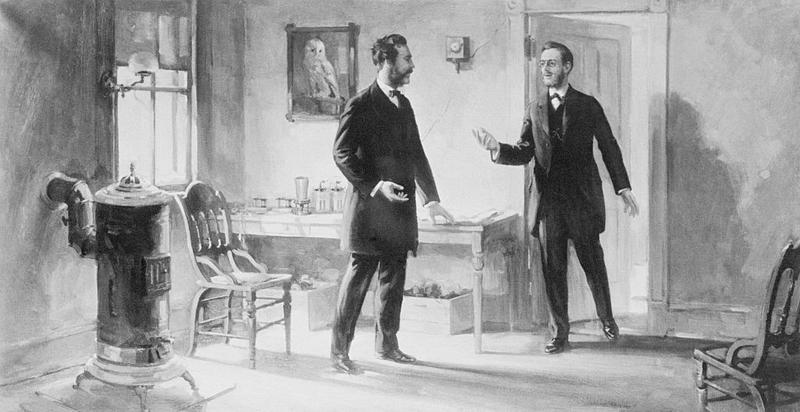“Mr. Watson – Come here—I want you”: Who was Alexander Graham Bell’s Assistant, Watson?
By Karen Harris | November 28, 2022

Alexander Graham Bell, the inventor of the telephone, was naturally the first person to place a telephone call. Did he call out for pizza? Did he phone a friend? Was it a prank call? Nope! Bell called his assistant, Thomas Augustus Watson, who was in the room next door. That very first phone call consisted of just seven words – “Mr. Watson – Come here – I want you.” Since his name is immortalized in the history of the telephone, it might be fitting to take a moment to look at the life of Alexander Graham Bell’s assistant, Thomas Watson.
Who Was Thomas Watson?
Thomas Augustus Watson, born on January 18, 1854, in Salem, Massachusetts, was a man of many talents. He worked as a carpenter, laborer, bookkeeper, and machinist prior to joining Bell Telephone Company, and he worked as a farmer, geologist, state treasurer, actor, ship builder, and businessman after his time at Bell. He was working for the Charles Williams machine shop in Boston in 1872 when a young inventor and a professor at nearby Boston University named Alexander Graham Bell came into the shop and asked to have some parts custom made. Bell explained what he needed to Thomas Watson … and why he needed them. Watson, intrigued by Bell’s project, asked all the right questions and offered all the right suggestions. He did a bang-up job machining the parts that Bell wanted. Bell returned to have Watson make additional parts for him.

The Telephone
Alexander Graham Bell’s invention of the telephone was really an offshoot of his studies in acoustics and working with members of the deaf community. Two of his hearing-impaired students, a six-year-old boy named Georgie Sanders and a 15-year-old girl named Mabel Hubbard, each had wealthy fathers. When Bell mentioned to these men that he was working on developing a type of audio telegraph machine, they offered him their financial backing. With those funds, Bell was able to hire Watson away from the Charles Williams machine shop and Watson became Bell’s assistant during the crucial development stage of the telephone.
Bell was not the only inventor working on the telephone. Another man, Elisha Gray, was dangerously close to getting his telephone to work before Bell, so Bell raced to the patent office to secure a patent on the telephone, even before he had a working prototype. Bell was issued his patent on March 7, 1876. Three days later, he finally got his telephone to work.
The First Phone Call
Alexander Graham Bell was still tinkering with his telephone on March 10, 1876. Before he could set up an official test run of the telephone, however, he found out that it worked … by accident. Bell was in one room of the lab while Thomas Watson was in another room, working on the equipment that would receive the telephone signal. That’s when Bell knocked over a vial of acid, spilling the harmful material onto his leg. Without thinking, Bell used his telephone to contact Watson in the next room.
Thomas Watson later explained that he heard Bell’s voice very clearly saying, “Mr. Watson … Come here … I want you” through the telephone receiver. After the acid spill was cleaned up, Bell made an entry into his journal about the first successful telephone call. Neither he nor Watson could remember the exact words that were used. The second part might have been “I want to see you” but the basic meaning was the same.

Thomas Watson, Inventor
Thomas Watson may have started out as Alexander Graham Bell’s assistant, but he became an inventor in his own right. While working for the Bell Telephone Company, he invented the telephone ringer. He recognized the need for a signal to let people know when a telephone call was coming in. Prior to Watson’s invention of the ringer, people had to watch the telephone receiver to know when they were getting a call, but no one wanted to stare at their phone all day waiting for a call to come in. Watson’s ringer system alerted people to a call using a polarized ringing system that could be heard throughout the house.
Watson After Bell Telephone
Thomas Watson was just 27 years old when he quit his job as Alexander Graham Bell’s assistant in 1881. Using the royalty money from his invention of the telephone ringer, Watson bought a farm. He discovered that farm life was not for him. He worked for a time as a geologist and was the State Treasurer of Massachusetts. He started his own company, Fore River Ship and Engine Building Company, in 1883. His company built naval destroyers for the U.S. military. By the turn of the century, Watson’s ship building company was one of the largest shipyards in the country. After he sold his company to Bethlehem Steel Corporation, Fore River Ship and Engine Building Company was a key player in supplying the U.S. Navy with ships during World War II. Thomas Watson used the profits from the sale of his company to support him as he tried his hand at acting.
Another Historic Phone Call
Thomas Watson was on the receiving end of the very first telephone call ever made, but he wasn’t done making telephone history. Watson also received the first transcontinental telephone call. Alexander Graham Bell placed the call on January 25, 1915, from his Bell Telephone Company building, located at 15 Dey Street in New York City. The call was received by Watson at 333 Grant Avenue in San Francisco. The mayors of New York City and San Francisco were on hand to speak to each over via telephone. President Woodrow Wilson was also involved and spoke to both Watson and the San Francisco mayor during the historic call.